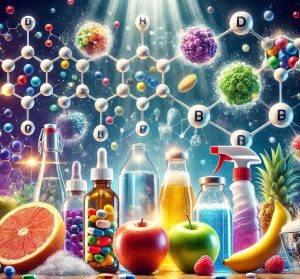Introduction
- Overview: Introduce carbohydrates, proteins, and enzymes as essential biomolecules crucial for life. Mention their roles in providing energy, supporting structure, and catalyzing biochemical reactions.
- Importance in Biology: Explain how these biomolecules work together in cells and are integral to biological processes such as metabolism, cellular communication, and structural support.
2. Carbohydrates
2.1 Structure and Classification
- Basic Structure: Carbohydrates are composed of carbon, hydrogen, and oxygen atoms in a roughly 1:2:1 ratio (C:H). Their general formula is (CH₂O)ₙ.
- Monosaccharides: Single sugar units like glucose, fructose, and galactose, which serve as the building blocks for larger carbohydrates.
- Disaccharides: Composed of two monosaccharides linked by glycosidic bonds (e.g., sucrose, lactose, maltose).
- Polysaccharides: Long chains of monosaccharides, serving structural (e.g., cellulose in plants) or storage roles (e.g., glycogen in animals, starch in plants).
2.2 Functions of Carbohydrates
- Energy Source: Glucose and other monosaccharides are primary sources of energy. Through glycolysis and cellular respiration, they are broken down to produce ATP.
- Energy Storage: Starch and glycogen act as energy reserves in plants and animals, respectively.
- Structural Role: Cellulose provides structural support in plant cell walls; chitin, a polysaccharide, provides structure in the exoskeletons of arthropods.
- Cellular Communication: Glycoproteins and glycolipids on cell surfaces are involved in cell recognition and signaling.
2.3 Biological Significance and Dietary Importance
- Discuss the importance of carbohydrates in the human diet and their role in maintaining blood sugar levels. Address complex vs. simple carbohydrates and their effects on metabolism.
- Fiber: A type of carbohydrate important for digestive health.
3. Proteins
3.1 Structure of Proteins
- Amino Acids: The building blocks of proteins. There are 20 standard amino acids, each containing an amino group, a carboxyl group, and a unique side chain (R group).
- Levels of Protein Structure:
- Primary Structure: The sequence of amino acids in a polypeptide chain.
- Secondary Structure: Localized folding into alpha-helices and beta-pleated sheets, stabilized by hydrogen bonds.
- Tertiary Structure: The 3D folding of the entire polypeptide chain, stabilized by various interactions (hydrophobic interactions, hydrogen bonds, disulfide bridges).
- Quaternary Structure: Some proteins consist of multiple polypeptide chains. For instance, hemoglobin has four subunits.
3.2 Functions of Proteins
- Enzymatic Catalysis: Enzymes, which are proteins, accelerate biochemical reactions (e.g., digestion, DNA replication).
- Structural Support: Proteins like collagen provide structural integrity in tissues such as skin, bone, and tendons.
- Transport: Hemoglobin transports oxygen in the blood; membrane proteins facilitate the transport of ions and molecules across cell membranes.
- Communication and Signaling: Hormones like insulin are proteins that signal cells to regulate blood sugar.
- Immune Response: Antibodies, which are proteins, recognize and neutralize foreign pathogens.
3.3 Protein Synthesis and Dietary Importance
- Protein Synthesis: Briefly outline transcription and translation as processes by which cells produce proteins.
- Essential Amino Acids: Explain that certain amino acids must be obtained from the diet, as the body cannot synthesize them.
- Dietary Role: Proteins are crucial for growth, repair, and maintenance of body tissues.
4. Enzymes
4.1 Nature and Structure of Enzymes
- Definition: Enzymes are biological catalysts that speed up chemical reactions without being consumed.
- Active Site: The specific region on an enzyme where the substrate binds and the reaction occurs.
- Enzyme-Substrate Complex: Formation of this complex is key to catalysis, as it lowers the activation energy needed for the reaction.
- Lock and Key vs. Induced Fit Models:
- Lock and Key Model: Enzyme’s active site is a specific shape that only fits the corresponding substrate.
- Induced Fit Model: Enzyme’s active site molds itself around the substrate upon binding for a better fit.
4.2 Mechanism of Enzyme Action
- Catalysis: Enzymes lower the activation energy of reactions, allowing them to occur at faster rates.
- Factors Affecting Enzyme Activity:
- Temperature: Optimal temperature increases enzyme activity; extremes can lead to denaturation.
- pH Levels: Each enzyme has an optimal pH; deviations can lead to denaturation.
- Substrate Concentration: Increasing substrate concentration generally increases reaction rate up to a point, after which enzymes are saturated.
4.3 Types of Enzymes and Their Functions
- Hydrolases: Catalyze hydrolysis reactions (e.g., lipases break down lipids).
- Oxidoreductases: Facilitate oxidation-reduction reactions (e.g., dehydrogenases).
- Transferases: Transfer functional groups between molecules (e.g., kinases).
- Isomerases: Catalyze rearrangement within molecules.
- Ligases: Join two molecules together with covalent bonds.
4.4 Applications of Enzymes in Industry and Medicine
- Industrial Uses:
- Food Industry: Enzymes like amylase are used in bread-making, lactase in lactose-free dairy, and proteases in tenderizing meat.
- Detergents: Enzymes in detergents help break down stains, particularly those from proteins and fats.
- Medical Applications:
- Diagnostics: Enzymes are used in tests like blood glucose monitoring.
- Therapeutics: Enzyme replacement therapy is used for certain metabolic disorders (e.g., pancrelipase in digestion).
5. Interrelationships Between Carbohydrates, Proteins, and Enzymes
- Metabolic Pathways: Explain how enzymes facilitate pathways that metabolize carbohydrates for energy, synthesize proteins, and break down cellular waste.
- Energy Transfer: Enzymes convert carbohydrates into ATP, which proteins use in cellular functions.
- Biochemical Synthesis: Enzymes enable the synthesis and breakdown of carbohydrates and proteins according to cellular needs.
10 Questions Along with their Answers, Covering Key Concepts about Carbohydrates, Proteins, and Enzymes:
1. What are the primary functions of carbohydrates in the body?
Answer: Carbohydrates primarily serve as an energy source. Simple carbohydrates (like glucose) provide immediate energy, while complex carbohydrates (like glycogen) serve as energy storage. Carbohydrates also play a role in cell structure, such as in the cell wall of plants (cellulose), and are important for cell signaling in the form of glycoproteins and glycolipids.
2. What is the difference between monosaccharides, disaccharides, and polysaccharides?
Answer: Monosaccharides are single sugar units (e.g., glucose, fructose). Disaccharides consist of two monosaccharides linked by a glycosidic bond (e.g., sucrose, lactose). Polysaccharides are long chains of monosaccharides, often used for energy storage (e.g., starch in plants, glycogen in animals) or structural support (e.g., cellulose in plants).
3. What is the basic structure of an amino acid?
Answer: An amino acid has a central carbon atom attached to four groups: an amino group (-NH₂), a carboxyl group (-COOH), a hydrogen atom, and a unique side chain (R group) that defines the specific amino acid. The sequence of amino acids in a protein determines its structure and function.
4. What are the four levels of protein structure?
Answer: The four levels of protein structure are:
- Primary Structure: The sequence of amino acids in a polypeptide chain.
- Secondary Structure: Local folding into alpha-helices and beta-pleated sheets, stabilized by hydrogen bonds.
- Tertiary Structure: The overall 3D shape of a polypeptide, determined by interactions between side chains.
- Quaternary Structure: The arrangement of multiple polypeptide subunits in a multi-subunit protein, such as hemoglobin.
5. How do enzymes function as biological catalysts?
Answer: Enzymes speed up biochemical reactions by lowering the activation energy needed for the reaction to occur. They bind substrates at their active site, forming an enzyme-substrate complex that facilitates the transformation of substrates into products. After the reaction, enzymes are released unchanged and can participate in additional reactions.
6. What factors affect enzyme activity?
Answer: Several factors influence enzyme activity:
- Temperature: Each enzyme has an optimal temperature. High temperatures can cause denaturation.
- pH Level: Enzymes have an optimal pH. Deviations can disrupt ionic bonds, leading to denaturation.
- Substrate Concentration: Higher substrate concentration increases reaction rate up to a saturation point where all enzyme active sites are occupied.
7. What is the difference between simple and complex carbohydrates?
Answer: Simple carbohydrates consist of one or two sugar units (e.g., glucose, sucrose) and are quickly digested, providing rapid energy. Complex carbohydrates (e.g., starch, glycogen) are polysaccharides that take longer to digest and provide sustained energy. Complex carbohydrates also often contain fiber, which aids in digestion.
8. How are proteins synthesized in the cell?
Answer: Protein synthesis occurs through two main processes:
- Transcription: DNA is transcribed into messenger RNA (mRNA) in the nucleus.
- Translation: mRNA is translated into a protein at the ribosome, where transfer RNA (tRNA) brings amino acids in the correct sequence to form the polypeptide chain, as determined by the mRNA sequence.
9. What role do carbohydrates play in cell recognition?
Answer: Carbohydrates on the cell surface form part of glycoproteins and glycolipids, which are involved in cell recognition and communication. These molecules allow cells to identify each other and interact appropriately, which is critical for immune responses, cell signaling, and tissue formation.
10. Why are enzymes essential in industrial and medical applications?
Answer: Enzymes are highly specific and efficient, making them ideal for various applications:
- Industrial Uses: Enzymes are used in food processing, biofuel production, and detergents to catalyze specific reactions.
- Medical Applications: Enzymes are used in diagnostics (e.g., blood glucose tests) and therapeutic treatments (e.g., enzyme replacement therapy). Their specificity helps in targeted treatment with fewer side effects.






